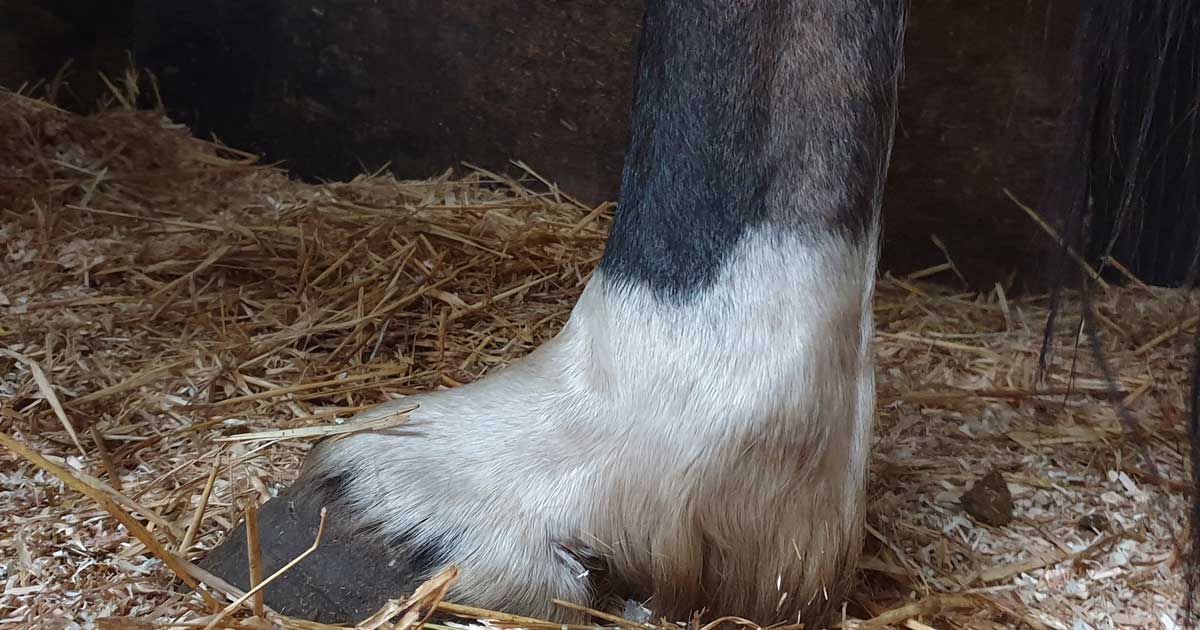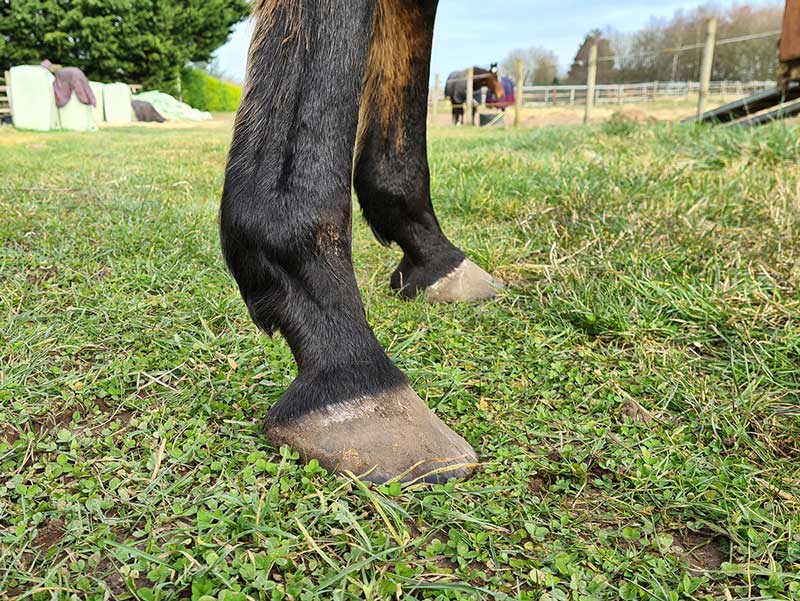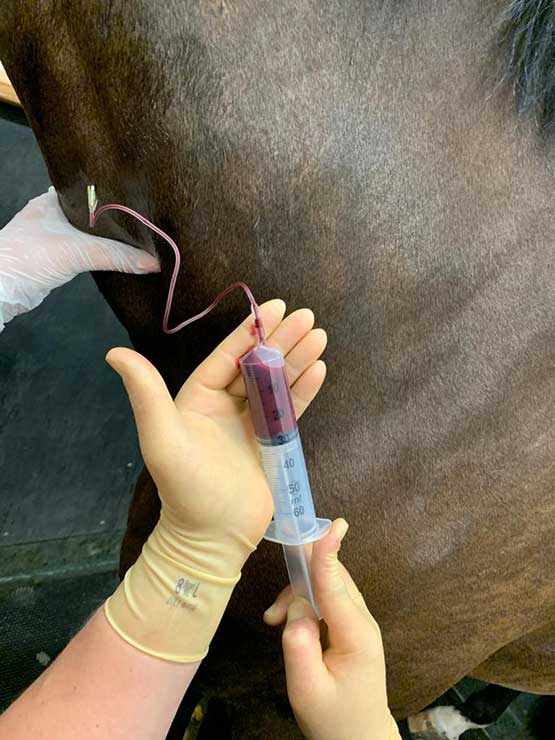14 Apr 2023
Diagnosis and treatment of lameness

Some conformations can preclude to certain injuries such as a very sloped pastern angle putting excess strain on palmar/plantar soft tissues.
Great. A first presentation, mild, hindlimb lameness to work up on the yard – an appointment booking that tends to fill you with woe. With the increase in referral facilities, and the wider availability of advanced imaging and specialists who know what they are looking for, what can you do stable-side to help this horse where the referral option isn’t available?
The answer is lots – as long as the owner (and you, the clinician) start with realistic expectations on what you are able to definitively diagnose and treat on site.
We all dream of the pathognomonic physical exam finding, or the overtly significant lameness that is easy to block out, but in reality, these are unfortunately few and far between. From your starting point of a relatively unexciting physical examination that doesn’t localise an area of suspicion, you have options on how to proceed:
- Bute and rest for a week (or weeks), and hope it goes away. This usually just delays the inevitable for a further seven (or more) days, but certainly can work in many cases.
- We go blocking. This is much more enticing if it’s a forelimb lameness, and if it’s at least 2/10 or ideally more.
- Screening radiographs, but prepare to be at least mildly disappointed in the wake of little or no findings.
- Trial treatment. This is a bold, but certainly not foolish strategy; however, it only works on a hunch (for example, medicating coffin joints for a forelimb lameness or tarsometatarsal joints in an older patient).
Assuming our “bute” and rest therapy was unsuccessful, when do we start blocking? Personally, out on a livery yard, it’s difficult to appreciate true responses to diagnostic local anaesthesia in anything less than 3/10 lame in the hindlimbs – forelimbs are slightly more forgiving.
The impact of an uneven ground surface and inconsistent handler can be quite significant – and both of these are very common in first opinion work. Without the luxury of a personal horse handler or technician, the ability for an owner to even trot a horse at a consistent pace in a well-controlled manner in a straight line is severely lacking, let alone lungeing consistently, and these can have real effects on your interpretation of nerve and joint blocks, which can lead to spurious results and misdiagnoses.
To effectively perform a decent blocking examination with meaningful results, you need a firm, flat, even surface of sufficient length to trot on, and a soft surface area for lungeing that isn’t too deep or rutted – all partnered with a handler who is confident, competent and consistent; especially for lamenesses that are more subtle.
Also, time. A decent lameness examination and investigation takes time, and depending on your workload, it can be difficult to find the three to four hours you need for these cases. If you end up rushing your blocks, you end up with confusing answers.
If you do happen to have the facilities, time and handler available, firstly, lucky you. But then cracking on with your blocking in a logical and consistent fashion is paramount – usually from distal to proximal, sticking to nerve blocks unless you have a specific suspicion of intra-articular pathology, and taking time to ensure you are happy if your block(s) are positive, partially positive or negative.
Screening radiographs can sometimes be fruitful – annoyingly not as frequently as you would like, but they do have their place for cases where the aforementioned criteria are not fulfilled to make blocking a nightmare, or if a horse is bad with needles, or even for a horse where you feel radiographs would be likely to pick up findings of significance; for example, a young or an older horse (developmental or degenerative orthopaedic disease, respectively).
Finding a nice OCD lesion or some arthritic hocks can be a one-shot diagnosis in some cases; however, it is always important in any situation to take a full set of good-quality, orthogonal view radiographs. Full-limb screening radiographs should equally be taken in a methodical fashion, radiographing each joint from all standard views. Poor-quality radiographs can miss the very thing you are hoping to find.
Trial treatment is also never a silly decision. Medicating the hocks of an 18-year-old ex-eventer with a hindlimb lameness, or the coffin joints of a showjumper with a forelimb lameness may (if not likely to) give you a good positive response without the need for exhaustive diagnostics. But needless to say, although an educated and likely guess, it is a guess nonetheless.
You may get only a transient response to treatment, or even no response at all, and in some cases you may end up exercising a horse that should have been rested and cause more issues for yourself.
Keeping expectations realistic is paramount. Without detailed and in-depth investigations, which may be difficult if not impossible stable-side, you may well not get to a definitive diagnosis and, therefore, may not end up with a quick and/or easy fix. Whatever diagnostic route (or combination of routes) you opt for, as long as it is logical and thought through, it is never the wrong one – unless the horse stays lame.

Treatment
Now, let’s open the can of worms that is treatment. Obviously, treatment varies hugely on your diagnosis – joint pathology, bony injury, soft tissue lesion and all the minutiae in between. But always start with the basics.
A lot of lamenesses will require a degree of rest; some will need a lot more. Rest itself is hugely underestimated as a treatment – and it can be a lot more than just “keep it in the stable for a week”. Duration of rest is important, as with some injuries – for example, mild to moderate superficial digital flexor tendon pathologies – you want to start controlled walking quite quickly, whereas the likes of a stress fracture or subchondral bone lesions will need much longer.
This also takes into account horse temperament. Some horses don’t cope well if confined to a stable, so will require outside-the-box thinking (pun slightly intended) to restrict movement. After this, your graded return to work and exercise will also need to be well thought out.
What duration do you want the horse walking for, and how many times a day? In hand or under saddle? How long until walking duration can be increased, and by how much? Can the owner do any specific exercises with the horse to help with rehabilitation (for example, ground pole work, use of training aids, or specific movements when walking, or even stable-based stretches and exercises)?
This then moves on to how long until trot work can be introduced, and at what duration and frequency? And then canter, then jumping and so on.
Plans need to be well thought out and tailored to the individual needs of the horse, and to the specific injury. What are you doing and why? These are always the paramount questions when devising any plan.
The rest period is also a great time to take into account the horse’s feet. Remedial or therapeutic trimming and shoeing can have a huge impact on orthopaedic injury and rehabilitation.
Always work with the farrier. Nothing makes things more hard work than telling an owner what they need to get their farrier to do. If you have foot radiographs, send them to the farrier. If you have specific requests or requirements regarding trimming or shoeing, chat to the farrier yourself. This way, things don’t get lost in translation, and you can explain your reasoning, rather than annoy a farrier by having them feel like you are telling them how to do their job.
Whether its rolling the toe, correcting imbalance or using a fancy type of shoe, farriery really can help with the dynamics of the whole limb, aiding in the rehabilitation of your lame horse.

Old, trusty NSAIDs are never a bad option. We have a glut of -azones, -coxibs and -ofens at our disposal, and all will have some beneficial effect on our lameness cases – as long as they have an inflammatory basis, which 9 times out of 10 they will be. However, once again, always ask yourself what you are doing and why?
The inflammatory phase of acute injuries (especially wounds) occur for a reason, and actually help in increasing vascularisation of the injured region to deliver cells and mediators to aid in tissue protection and repair.
The downsides come when this process is prolonged and unregulated. So, in some (if not many) cases of acute injury, delaying NSAIDs may be wise in the long term to allow the normal and beneficial acute inflammatory process to occur.
Intra-articular medications can be a more targeted approach to joint pathology. Of course, our steroids – be it triamcinolone, methylpredinsolone or betamethasone – are usually the top choice, for the main reasons that they are extremely effective (in the right situations) and relatively safe. Obviously, our steroid-associated laminitis risks can preclude use in some patients, or at least make us alter our dose rates. However, the (relatively) new kid on the block has become a great “go-to” in these cases.
Polyacrylamide hydrogel has been found to have similar if not superior beneficial effects on pathologic joints1 with none of the associated laminitis risks – a great (but unfortunately much more expensive) option for these cases.
Biologics are becoming a lot more accessible these days, and platelet-rich plasma products merely require a centrifuge and the appropriate kit to get the finished product. Interleukin receptor antagonist protein products are also relatively accessible, needing only an incubator in addition to the centrifuge.

New stem cell products use peripheral blood stem cells, so are much easier to “harvest” stable-side; however, they do require special ultra-low temperature storage equipment.
These biologic products, in all their fancy forms, aim to help the repair and healing of injuries, rather than just amelioration of inflammation and pain, so are indicated more in acute rather than chronic pathologies; however, numerous reports exist of chronic arthritis cases benefiting from these treatments, as well2-4.
A raft of other treatments and therapies such as bisphosphonates, polysulphated polysaccharides, oral joint supplements and extracorporeal shockwave therapy – to name but a few – are also easily used in an ambulatory setting, adding more strings to our already crowded bow. A lot of boundaries exist to what is achievable in a first opinion setting, but as long as expectations remain realistic on all sides, a lot is still possible.
- Use of some of the drugs mentioned in this article is under the veterinary medicine cascade.
References
- de Clifford LT, Lowe JN, McKellar CD, McGowan C and David F (2021). A double-blinded positive control study comparing the relative efficacy of 2.5 per cent polyacrylamide hydrogel (PAAG) against triamcinolone acetonide (TA) and sodium hyaluronate (HA) in the management of middle carpal joint lameness in racing Thoroughbreds, Journal of Equine Veterinary Science 107: 103780.
- Smith NA, Murawski CD, Fortier LA, Cole BJ and Kennedy JG (2013). Platelet-rich plasma in the pathologic process of cartilage: review of basic science evidence, Arthroscopy 29(8): 1,399-1,409.
- Frisbie DD, Kawcak CE, Werpy NM, Park RD and McIlwraith CW (2007). Clinical, biochemical, and histologic effects of intra-articular administration of autologous conditioned serum in horses with experimentally induced osteoarthritis, American Journal of Veterinary Research 68(3): 290-296.
- Abellanet I and Prades M (2009). Intra-articular platelet rich plasma (PRP) therapy: evaluation in 42 sport horses with OA, Proceedings of the 11th World Equine Veterinary Association Conference, San Paulo.
